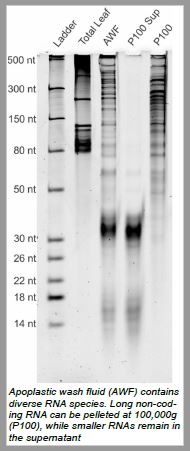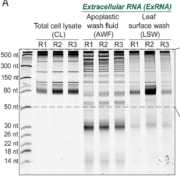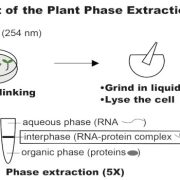Plant cells secrete diverse RNA species, including small RNAs, long noncoding RNAs and circular RNAs
By: Hana Zand Karimi and Roger W. Innes, Indiana University
Background: To prevent infection by disease-causing microbes, plants secrete diverse antimicrobial compounds into their extracellular spaces. Included among these compounds are small RNA molecules 21-24 nucleotides in length (sRNAs) that can be taken up by microbes. These sRNAs are thought to cause the destruction of messenger RNAs having complementary sequences. The processes by which sRNAs are secreted, how they are protected from degradation, and how they are taken up by pathogenic microbes are all poorly understood.
Questions: Although extracellular sRNAs have been shown to copurify with extracellular vesicles (EVs), their exact location had not been clearly established. Are sRNAs located inside or outside EVs? Also, do plants secrete RNAs longer than 24 nucleotides?
 Findings: We isolated EVs from the extracellular spaces of Arabidopsis leaves and then treated these preparations with RNase A to degrade naked RNA or with protease plus RNase A to degrade RNA protected by proteins. Our analyses revealed that sRNAs are associated with protein complexes that are located outside EVs. Significantly, we found that Arabidopsis secretes both sRNAs and much longer RNAs, ranging from 30 to over 500 nucleotides in length. These longer RNAs do not code for proteins, and many have a circular structure. Notably, both these long noncoding RNAs and the sRNAs were found to be highly enriched in a posttranscriptional modification known as N6-methyladenine. We speculate that this modification might be required for secretion of RNA.
Findings: We isolated EVs from the extracellular spaces of Arabidopsis leaves and then treated these preparations with RNase A to degrade naked RNA or with protease plus RNase A to degrade RNA protected by proteins. Our analyses revealed that sRNAs are associated with protein complexes that are located outside EVs. Significantly, we found that Arabidopsis secretes both sRNAs and much longer RNAs, ranging from 30 to over 500 nucleotides in length. These longer RNAs do not code for proteins, and many have a circular structure. Notably, both these long noncoding RNAs and the sRNAs were found to be highly enriched in a posttranscriptional modification known as N6-methyladenine. We speculate that this modification might be required for secretion of RNA.
Next steps: The discovery that plants secrete long noncoding RNAs, including circular RNAs, was unexpected and raises the question as to why. Do they play a role in cell-to-cell communication within the plant? Are they an important component of the immune system? How are these RNAs secreted and what are the roles of RNA-binding proteins and posttranscriptional modifications in this process?
Hana Zand Karimi, Patricia Baldrich, Brian D. Rutter, Lucía Borniego, Kamil K. Zajt, Blake C. Meyers, and Roger W. Innes. (2022). Arabidopsis apoplastic fluid contains sRNA- and circular RNA-protein complexes that are located outside extracellular vesicles. Plant Cell. https://doi.org/10.1093/plcell/koac043






